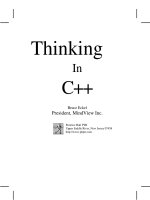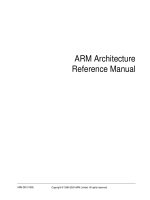Tài liệu MySQL Pocket Reference, Second Edition doc
Bạn đang xem bản rút gọn của tài liệu. Xem và tải ngay bản đầy đủ của tài liệu tại đây (916.59 KB, 134 trang )
MySQL
Pocket ReferenceMySQL
Pocket Reference
SECOND EDITION
George Reese
Beijing
•
Cambridge
•
Farnham
•
Köln
•
Paris
•
Sebastopol
•
Taipei
•
Tokyo
MySQL Pocket Reference, Second Edition
by George Reese
Copyright © 2007, 2003 George Reese. All rights reserved.
Printed in Canada.
Published by O’Reilly Media, Inc., 1005 Gravenstein Highway North,
Sebastopol, CA 95472.
O’Reilly books may be purchased for educational, business, or sales
promotional use. Online editions are also available for most titles
(safari.oreilly.com). For more information, contact our corporate/
institutional sales department: (800) 998-9938 or
Editor:
Andy Oram
Production Editor:
Laurel R.T. Ruma
Copyeditor:
Genevieve d’Entremont
Proofreader:
Laurel R.T. Ruma
Indexer:
Johnna VanHoose Dinse
Cover Designer:
Karen Montgomery
Interior Designer:
David Futato
Printing History:
February 2003: First Edition.
July 2007: Second Edition.
Nutshell Handbook, the Nutshell Handbook logo, and the O’Reilly logo are
registered trademarks of O’Reilly Media, Inc. The Pocket Reference series
designations, MySQL Pocket Reference, the image of a kingfisher, and
related trade dress are trademarks of O’Reilly Media, Inc.
Many of the designations used by manufacturers and sellers to distinguish
their products are claimed as trademarks. Where those designations appear
in this book, and O’Reilly Media, Inc. was aware of a trademark claim, the
designations have been printed in caps or initial caps.
While every precaution has been taken in the preparation of this book, the
publisher and author assume no responsibility for errors or omissions, orfor
damages resulting from the use of the information contained herein.
ISBN-10: 0-596-51426-3
ISBN-13: 978-0-596-51426-6
[TM]
v
Contents
Introduction 1
MySQL 5 2
Views 3
Triggers 3
Stored Procedures 3
Cursors 4
New Storage Engines 4
Database Events 5
Setup 5
Downloading MySQL 5
Configuration 6
Startup 8
Set the Root Password 10
Replication 10
Command-Line Tools 12
Data Types 15
Numerics 16
Strings 21
Dates 26
Complex Types 28
vi
|
Contents
SQL 30
Case Sensitivity 31
Literals 31
Identifiers 33
Comments 34
Commands 35
Transaction Rules 86
Operators 87
Rules of Precedence 87
Arithmetic Operators 88
Comparison Operators 89
Logical Operators 91
Functions 91
Aggregate Functions 91
General Functions 93
Storage Engines 114
Stored Procedures and Functions 115
Parameters 116
Logic 117
Handlers and Conditions 122
Triggers 123
Index 125
1
Chapter 1
MySQL Pocket Reference
Introduction
When I fly across the country, I often pass the hours pro-
gramming on my PowerBook. If that programming involves
MySQL, I inevitably end up lugging around the book I co-
wrote, Managing and Using MySQL (O’Reilly). I don’t carry
around the book to show it off; the problem is that no mat-
ter how experienced you are with MySQL, you never know
when you will need to look up the exact syntax of an obscure
function or SQL statement.
The MySQL Pocket Reference is a quick reference that you
can take with you anywhere you go. Instead of racking your
brain for the exact syntax of a variant of
ALTER TABLE that you
generally never use, you can reach into your laptop case and
grab this reference. As an experienced MySQL architect,
administrator, or programmer, you can look to this reference.
This book does not, however, teach MySQL. I expect that
you have learned or are in the process of learning MySQL
from a book such as Managing and Using MySQL. Though I
start with a reference on MySQL setup, it is designed to help
you remember the full process of MySQL configuration—not
to teach you the process.
2
|
MySQL Pocket Reference
Acknowledgments
I first would like to thank my editor Andy Oram, as always,
for helping me along. I would also like to thank the book’s
strong technical reviewers, Paul Dubois, Judith Myerson, and
Tim Allwine. Finally, I would like to thank my co-authors for
Managing and Using MySQL, Tim King and Randy Jay
Yarger, who helped set the foundation that made this pocket
reference possible and necessary.
Conventions
The following conventions are used in this book:
Constant width
Used to indicate anything that might appear in a pro-
gram, including keywords, function names, SQL com-
mands, and variable names. This font is also used for
code examples, output displayed by commands, and sys-
tem configuration files.
Constant width bold
Used to indicate user input.
Constant width italic
Used to indicate an element (e.g., a filename or variable)
that you supply.
Italic
Used to indicate directory names, filenames, program
names, Unix commands, and URLs. This font is also
used to introduce new terms and for emphasis.
MySQL 5
If you have been using MySQL for a while, you really don’t
need to learn a thing about MySQL 5 to keep going. Every-
thing you are used to using still works just as it always has.
For the most part, MySQL 5 is about adding enterprise
MySQL 5
|
3
database features seen in other database engines without
burdening MySQL with concepts that make it harder to learn
and use.
Views
Views are denormalized, table-like structures that represent a
snapshot of your data that match specific query parameters.
You can thus represent as data from a single table the result
of a complex join. New commands supporting views include
CREATE VIEW, DROP VIEW, and ALTER VIEW.
Triggers
A database trigger is functionality that you create that gets
executed whenever a specific event occurs on a table. For
example, you can trigger behavior for a table whenever a new
row is inserted. New commands supporting triggers include
CREATE TRIGGER and DROP TRIGGER.
Stored Procedures
Stored procedures are the big feature most people have been
waiting for. A stored procedure is much like creating a func-
tion that is written entirely in SQL and stored in the database.
Stored procedures are useful for encapsulating a number of
SQL statements that always get executed together under a sin-
gle logical name for use by clients. MySQL includes a number
of new commands to support stored procedures:
• CREATE PROCEDURE
• ALTER PROCEDURE
• DROP PROCEDURE
• CALL
• BEGIN/END
4
|
MySQL Pocket Reference
Cursors
A cursor is a tool that enables you to represent an entire data
set within a MySQL stored procedure. MySQL cursors are lim-
ited in that they are asensitive (a quality affecting their
response to changes in the table), nonscrolling (cursors must
be used sequentially, moving forward), and read-only. New
commands supporting cursors include
OPEN, FETCH, and CLOSE.
New Storage Engines
The most common storage engines (also known as table
types) in MySQL are MyISAM and InnoDB. But a number of
new ones were added in recent versions of MySQL:
ARCHIVE
Offers fast stores and selects without indexes, but no
updates or deletions.
BLACKHOLE
Discards data; used to support replication.
CSV
Stores data in a comma-separated values format com-
monly used for plain text data exchange.
FALCON
A new general-purpose data storage engine that may
one day replace InnoDB. It is currently somewhat
experimental.
FEDERATED
Offers access to a database on a remote server.
MERGE
Combines multiple MyISAM tables.
NDB/NDBCLUSTER
Network database, used with MySQL Cluster.
Setup
|
5
Database Events
Introduced with MySQL 5.1, database events allow you to
arrange for SQL that runs at a specified time in the future
either once, or on a recurring calendar.
Setup
You can install MySQL by compiling the source code with
the options that best suit your needs, or by downloading and
installing a prebuilt binary. In general, you’ll want to use the
package management system (such as the BSD ports system)
appropriate to your operating system. You can also find both
binary and source code at the MySQL web site, http://www.
mysql.com.
Before installing using either approach, you need to prepare
your operating system for MySQL. Specifically, you should
create a mysql user and group under which MySQL will run.
Downloading MySQL
MySQL AB changes the download process somewhat fre-
quently, so the exact process of downloading MySQL may
vary from the details described here. MySQL comes in stan-
dard and debug packages. When in doubt, get the standard
package. It is generally what you will want for a production
server.
If you are having runtime problems with your MySQL envi-
ronment, you can test your application against a Debug
install to get detailed debug information on your MySQL
operation. You do not want to use the Debug package for any
production environment.
The MySQL download page also provides a variety of addi-
tional tools, including test suites, client utilities, libraries,
and header files. These tools are not essential to getting
6
|
MySQL Pocket Reference
MySQL up and running, though they may be necessary for
programming on a machine without a MySQL server installa-
tion or just to make life easier.
Configuration
MySQL has three different kinds of configuration, both for
the server process at server startup and for the client pro-
cesses when a user executes them. In order of preference,
these configuration options include:
1.
Command-line options
2.
Configuration file options
3.
Environment variable options
In other words, if you have the
password option specified on
the command line, in your configuration file, and in an envi-
ronment variable, the command-line option wins. Table 1
shows a list of configuration options. Each option applies to
one or more MySQL tools, depending on the context.
Table 1. MySQL configuration options
Option Description
basedir=directory Specifies the root directory of your MySQL
installation.
Batch
Executes in batch mode, meaning no
command-line prompts or other
information is sent to stdout. This is the
default mode when used with a pipe.
character-sets-dir=directory Specifies where yourcharacterset files are
stored.
Compress
Tells the client and server to use
compression in the network protocol.
datadir=directory Specifies the location of MySQL’s data
files.
debug=options Specifies a list of debug options.
Setup
|
7
A MySQL configuration file has the following format:
# Example MySQL configuration file
#
# These options go to all clients
[client]
password = my_password
port = 3306
socket = /var/lib/mysql/mysql.sock
Force
Indicates that you want processing to
continue for client utilities even when an
error is encountered.
host=hostname Identifies the host to which a client
should connect by default.
language=language Specifies the language to use for
localization.
password=password Specifies a default password for clients to
use to connect.
port=port_# Specifies the port number to which the
server should listen and to which clients
should connect.
Silent
Silently exit if a connection failure occurs.
skip-new-routines
Tells the MySQL server to avoid new,
potential buggy routines.
sleep=seconds Sleep between commands.
socket=name Socket file to use for local connections.
user=username Specifies the user name to use for client
connections.
variable-name =value Sets the specified variable name to a
particular value.
Verbose
Tells MySQL to talk more about what is
happening.
Wait
Tells the client to wait after a connection
failure and then retry the connection.
Table 1. MySQL configuration options (continued)
Option Description
8
|
MySQL Pocket Reference
# These options are specifically targeted at the mysqld
server
[mysqld]
port = 3306
socket = /var/lib/mysql/mysql.sock
max_allowed_packet=1M
MySQL supports multiple configuration files. As a general
rule, it checks files in the following order of preference:
1.
User configuration file (Unix only).
2.
Configuration file specified through the defaults-
extra-file=filename
option.
3.
A configuration file in the MySQL data directory.
4.
The system configuration file.
In all cases except the command-line and user configuration
options, the name of the configuration file on Unix is my.cnf
and on Windows is my.ini. A Unix user can override system
configuration information by building his own configuration
file in ~/.my.cnf. The system configuration file on a Unix sys-
tem is /etc/my.cnf. Windows, on the other hand, has two
system configuration locations, in order of preference:
1.
C:\my.cnf
2.
C:\WINNT\System32\my.cnf
You can alternately specify a file on the command line using
the
defaults-file=filename option. This option causes all
options specified in other files to be ignored, even if they are
not overridden in the file you specify.
Startup
In general, you will want MySQL to begin running when the
operating system comes up. How you do this depends on
your operating system.
Setup
|
9
Mac OS X
The modern Mac OS X binary package automatically sets itself
up to launch on start. To verify this, you should see a /Library/
StartupItems/MySQLCOM/ directory on your hard drive.
Solaris
The MySQL binary for Solaris does not set itself up as a ser-
vice to run at startup. It nevertheless sets up a Solaris mani-
fest file in /var/svc/manifest/application/database/mysql.xml.
You should first verify that this file exists. If not, check the
MySQL distribution for a Solaris manifest or look on the
Internet. To set up MySQL to launch on startup, first verify it
is not yet set to run on startup:
$ svcs mysql
If you see the following:
svcs: Pattern 'mysql' doesn't match any instances
STATE STIME FMRI
The service is not yet installed. To install the service:
$ svccfg import /var/svc/manifest/application/database/
mysql.xml
One installed, you should see the following:
$ svcs mysql
STATE STIME FMRI
disabled Mar_10 svc:/application/database/mysql:
default
To start MySQL and have it run on start-up, execute:
$ svcadm enable mysql
Other Unix
Setting up other variants of Unix is as simple as copying the
script mysql.server from the source’s support-files directory to
your version of Unix’s startup directory and making sure it is
executable by root. Under FreeBSD, for example, place this
script in /usr/local/etc/rc.d.
10
|
MySQL Pocket Reference
Once installed, you should run the mysql_install_db tool to
set up your databases.
Set the Root Password
After starting the server, and before doing anything else, set a
password for the root user:
mysqladmin -u root password a_good_password
Replication
Configuring two MySQL server instances to use replication
requires you to set up one as the replication master (i.e., the
authoritative database) and the other as a replication slave.
Configuration of the server involves nothing more than set-
ting it up for binary logging and specifying a server ID. When
you configure a server for binary logging, you are telling it to
save all transactions against it to a binary logfile. Slaves can
later read this logfile and determine what transactions to rep-
licate into their respective environments.
Master configuration
As just noted, you must set up binary logging on the master
for replication to work. You also need to give the server a
server ID. All of this is done through the MySQL configura-
tion file:
[mysqld]
log-bin=mysql-bin
server-id=1
The server ID is an arbitrary integer (pick whatever value you
like), but it must be unique across all MySQL servers in your
infrastructure. You will also be handing out IDs to the repli-
cation slaves.
Slaves must connect to the master using a valid MySQL user
with
REPLICATION SLAVE privileges. You can either use an
existing user or set up a user specifically for replication.
Setup
|
11
Slave configuration
As with the master, you need to configure the MySQL slave
server to have a unique server ID.
With both the slave and master configured with unique IDs
and binary logging enabled on the master, you next need to
get some basic configuration information from the master.
What makes this complicated is that you need to get this
information from the master while no updates are occurring.
To accomplish this, start a client on the master and enter:
mysql> FLUSH TABLES WITH READ LOCK;
Query OK, 0 rows affected (0.30 sec)
mysql> SHOW MASTER STATUS;
+ + + +
+
| File | Position | Binlog_Do_DB | Binlog_
Ignore_DB |
+ + + +
+
| crm114-bin.000044 | 98 | |
|
+ + + +
+
1 row in set (0.05 sec)
And in another window, while your mysql client with the
lock is still running, enter:
$ mysqldump master-data -uroot -p DATABASE_TO_REPLICATE
> /var/tmp/master.dump
If you need to replicate existing data, you will need to leave
the client running mysql open so that your lock remains in
place while running mysqldump. Failure to do so may result
in corruption on the slave.
You can then take your dump file to your slave and import
the file. Before importing it, however, you should edit the
CHANGE MASTER command near the top of the file to include the
proper master server, user name, and password. Make sure
to retain the position and logfile values!
12
|
MySQL Pocket Reference
Once done with your changes, start the slave with the skip-
slave
option, load the dump file into your slave, start the slave
threads, and you are ready to go.
You can use the same master dump to set up any number of
slaves.
Command-Line Tools
You can interact with MySQL entirely from the command
line. In general, each MySQL command accepts as an argu-
ment any appropriate option from the configuration options
listed earlier. You prefix any such option with two dashes:
mysql user=username
In addition, each of these options has a short form:
mysql -uusername
To see which options apply to individual commands and
their short forms, refer to the manpage for the command in
question using the following command:
$ man -M/usr/local/mysql/man mysql
MySQL provides the following command-line tools:
msql2mysql
This utility is handy for people converting applications
written for mSQL to MySQL. These days, however, few
people need this help.
myisamchk
This tool verifies the integrity of your MyISAM tables
and potentially fixes any problems that it detects.
mysql
The MySQL interactive SQL interpreter. It enables you
to execute SQL on the command line. You can span your
SQL across any number of lines. The tool executes your
SQL when you terminate it with a semicolon or the
escape sequence
\g.
Command-Line Tools
|
13
mysql_upgrade
After you install a new version of MySQL, you can run
this utility to examine your tables and make sure they are
consistent with your new version of MySQL. You should
run this command each time you upgrade MySQL.
mysqladmin
The MySQL administrative interface. Though many of
this tool’s functions can be accomplished using SQL and
the mysql command-line utility, it nevertheless provides a
quick way to perform an administrative task straight
from the Unix command line without entering an SQL
interpreter. You can specifically execute the following
administrative commands:
create
databasename
Creates the specified database.
drop
databasename
The opposite of create, this command destroys the
specified database.
extended-status
Provides an extended status message from the server.
flush-hosts
Flushes all cached hosts.
flush-logs
Flushes all logs.
flush-status
Flushes all status variables.
flush-tables
Flushes all tables.
flush-threads
Flushes the thread cache.
flush-privileges
Forces MySQL to reload all grant tables.
14
|
MySQL Pocket Reference
kill id[,id]
Kills the specified MySQL threads.
password
new_password
Sets the password for the user to the specified new
password.
mysqladmin -u root password new_password
should be the first thing you do with any new
MySQL install.
ping
Verifies that mysqld is actually running.
processlist
Shows the active MySQL threads. You can kill these
threads with the
mysqladmin kill command.
reload
Reloads the grant tables.
refresh
Flushes all tables, closes all logfiles, then opens them
again.
shutdown
Shuts MySQL down.
status
Shows an abbreviated server status.
variables
Prints out available variables.
version
Displays the server version information.
mysqlaccess
A command-line interface for managing users. This tool
is basically a shortcut for the SQL
GRANT command.
mysqlcheck
This tool is a data integrity verifier much like myisamchk.
A key difference is that you run this tool while MySQL is
Data Types
|
15
running. Exactly what kind of checks and fixes occur
vary from database engine to database engine.
mysqld
The MySQL server process. You should never start this
directly; instead use mysqld_safe.
mysqld_safe
The server process manager. (Under MySQL versions
prior to MySQL 4.0, this script was called safe_mysqld.)
It is a process that starts up the mysqld server process and
restarts it should it crash. Note that the mysql.server star-
tup script executes mysqld_safe as the appropriate user at
server startup.
mysqldump
Dumps the state of a MySQL database or set of data-
bases to a text file that you can later use to restore the
databases you dumped.
mysqlimport
Imports text files in a variety of formats into your data-
base. It expects the base name (the name of the file with-
out its extension) to match the name of the table you will
import.
mysqlshow
Displays the structure of the specified MySQL database
objects, including databases, tables, and columns.
mysqlslap
A tool to emulate client load on your MySQL server.
Data Types
For each data type, the syntax shown uses square brackets
(
[]) to indicate optional parts of the syntax. The following
example shows how
BIGINT is explained in this chapter:
BIGINT[(display_size)]
16
|
MySQL Pocket Reference
This indicates that you can use BIGINT alone or with a dis-
play size value. The italics indicate that you do not enter
display_size literally, but instead enter your own value. Pos-
sible uses of
BIGINT include:
BIGINT
BIGINT(20)
In addition to the BIGINT type, many other MySQL data types
support the specification of a display size. Unless otherwise
specified, this value must be an integer between 1 and 255.
Before MySQL 5, MySQL would silently change column val-
ues in certain circumstances. As of MySQL 5, these silent
changes no longer happen.
VARCHAR → CHAR
When the specified VARCHAR column size is less than four
characters, it is converted to
CHAR.
CHAR → VARCHAR
When a table has at least one column of a variable
length, all
CHAR columns greater than three characters in
length are converted to
VARCHAR.
TIMESTAMP display sizes
Display sizes for
TIMESTAMP fields must be an even value
between 2 and 14. A display size of 0 or greater than 14
converts the field to a display size of 14. An odd-valued
display size is converted to the next highest even value.
MySQL 5 no longer takes a size value for timestamps.
Numerics
MySQL supports all ANSI SQL2 numeric data types. MySQL
numeric types break down into integer, decimal, and float-
ing point types. Within each group, the types differ by the
amount of storage required for them.
Numeric types allow you to specify a display size, which
affects the way MySQL displays results. The display size
bears no relation to the internal storage provided by each
Data Types
|
17
data type. In addition, the decimal and floating point types
allow you to optionally specify the number of digits that fol-
low the decimal point. In such cases, the digits value should
be an integer from 0 to 30 that is at most two less than the
display size. If you do make the digits value greater than two
less than the display size, the display size will automatically
change to two more than the digits value. For instance,
MySQL automatically changes
FLOAT(6,5) to FLOAT(7,5).
When you insert a value into a column that requires more
storage than the data type allows, it will be clipped to the
minimum (negative values) or maximum (positive values)
value for that data type. MySQL will issue a warning when
such clipping occurs during
ALTER TABLE, LOAD DATA INFILE,
UPDATE, and multirow INSERT statements. The exception is
when you are running MySQL 5 or later under strict SQL
mode, in which case MySQL will raise an error for inserts
and updates.
The
AUTO_INCREMENT attribute may be supplied for at most
one column of an integer type in a table. The
UNSIGNED
attribute may be used with any numeric type. An unsigned
column may contain only nonnegative integers or floating-
point values. The
ZEROFILL attribute indicates that the col-
umn should be left padded with zeros when displayed by
MySQL. The number of zeros padded is determined by the
column’s display width.
BIGINT
BIGINT[(display_size)] [AUTO_INCREMENT] [UNSIGNED] [ZEROFILL]
Storage
8 bytes
Description
Largest integer type, supporting a range of whole numbers from
-9,223,372,036,854,775,808 to 9,223,372,036,854,775,807 (0 to
18,446,744,073,709,551,615 unsigned). Because of the way
18
|
MySQL Pocket Reference
MySQL handles BIGINT arithmetic, you should avoid performing
any arithmetic operations on unsigned
BIGINT values greater than
9,223,372,036,854,775,807. If you do, you may end up with
imprecise results.
BIT
BIT[(bits)]
Storage
bits bits + 7 or 8 bits (approximately)
Description
Prior to MySQL 5.0.3, a BIT field behaved exactly like a
TINYINT(1) field. This data type stores a bitmap value of the speci-
fied number of bits. If you enter a value requiring fewer bits than
allowed for the field, MySQL will pad the left bits with zeroes.
DEC
Synonym for DECIMAL.
DECIMAL
DECIMAL[(precision, [scale])] [UNSIGNED] [ZEROFILL]
Storage
Varies
Description
Stores floating-point numbers where precision is critical, such as
for monetary values.
DECIMAL types require you to specify the
precision and scale. The precision is the number of significant
digits in the value. The scale is the number of those digits that
come after the decimal point. For example, a
BALANCE column
declared as
DECIMAL(9, 2) would store numbers with nine signifi-
cant digits, two of which are to the right of the decimal point.
The range for this declaration would be -9,999,999.99 to
9,999,999.99. If you specify a number with more decimal points,
it is rounded to fit the proper scale. Values beyond the range of
the
DECIMAL are clipped to fit within the range.









